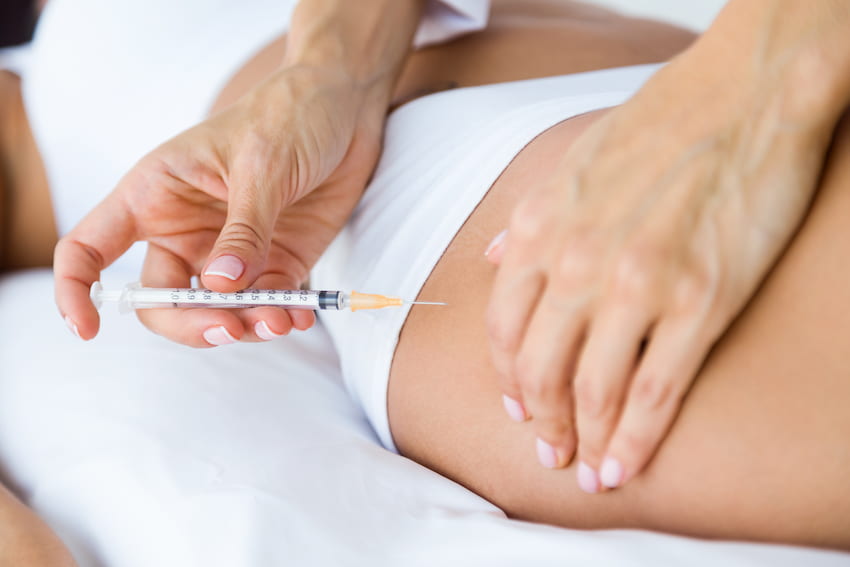
Weight Management Medication: Where to Inject Saxenda?
The interest in Saxenda has risen drastically, especially for weight loss and diabetes management. More and more information is appearing on social media about Saxenda pen and treatment options. It is shown as an effective way to lose weight and maintain optimal blood sugar levels in diabetes. Thus, it has appeared many questions about how to inject Saxenda properly and get the desired results.
This post is your key to unlocking Saxenda. We will explain the main features of subcutaneous injections, dose settings, and safety guidelines. Keep reading to get all the information for safe Saxenda treatment.
Before we start, if you’d like to take the first step towards a healthier lifestyle, you can purchase Saxenda at Insulin.store. We are a verified Canadian pharmaceutical company.
Saxenda Basic Information
Saxenda is a medication designed to help adults tackle chronic weight issues. Its active ingredient, liraglutide, works by regulating appetite and body weight. Saxenda may be recommended for patients who have a BMI over 30 or are struggling with conditions like high blood pressure, type 2 diabetes, or high cholesterol.
The FDA approved Saxenda in 2014 as a supplementary treatment to diet and exercise, specifically aimed at chronic weight management in adults classified as obese or overweight and dealing with at least one weight-related health condition.
Saxenda Mechanism of Action
Classification of Saxenda as a GLP-1 receptor agonist lies at the core of its mechanism of action. GLP-1, or glucagon-like peptide-1, is a natural hormone found in the gut.
Saxenda’s active ingredient, liraglutide, mimics the functions of GLP-1. One key role of GLP-1 is the regulation of appetite. Saxenda injection leads to a heightened feeling of fullness (satiety) and decreased appetite. These processes reduce calorie intake, aiming to achieve optimal results in weight loss plans.
Injecting Saxenda influences gastric emptying, slowing it down. This impact prolongs digestion and the sustained release of nutrients in the bloodstream. The extended nutrient absorption process aids in supporting more stable blood sugar levels. Understanding how long Saxenda stays in your system can be crucial for managing its effects and planning your dosage schedule.
Saxenda provides patients with a powerful tool to achieve their weight loss goals in conjunction with lifestyle modifications.
Subcutaneous Injection and Its Aim
The term “subcutaneous” refers to injecting medication into the fatty tissue beneath the skin. Unlike other injection methods, such as intramuscular or intravenous, subcutaneous injections are known for their slow absorption rate. It results in reduced pain and simpler administration.
Saxenda employs subcutaneous injections strategically for several reasons. The fatty subcutaneous layer acts as a natural reservoir for the medication, facilitating a gradual and consistent absorption into the bloodstream.
Where to Inject Saxenda
Subcutaneous injection is a key step of Saxenda self-administration. Knowing where to inject Saxenda is crucial for optimal outcomes. When preparing for a Saxenda injection, the subcutaneous layer of the skin becomes the target. Here are the best sites for injection:
Abdomen: A quick pinch of the stomach area provides an ample layer of fat for the Saxenda needle.
Thigh or Upper Leg: For those who find the abdomen area sensitive, the upper front and outer areas of the thigh serve as alternative injection sites. The thigh is less sensitive, offering convenience for self-injection.
Upper Arm: Though less convenient for injection, the back of the upper arm is another option. It provides an alternative for those who might experience difficulty in the abdomen area.
Rotation Of Injection Sites
To avoid complications such as skin problems and uneven absorption, it’s crucial to rotate injection sites. Injecting in the same spot repeatedly can lead to discomfort and skin-related issues. Therefore, a rotation strategy is recommended for Saxenda users. Develop a systematic rotation schedule to keep track of your injection sites or establish a clear pattern for site rotation. This could involve moving clockwise or counterclockwise, like circular motion, around each designated area. The key is to avoid injecting in the same location twice in a row.
Preparation for Subcutaneous Injection
The preparatory phase for Saxenda injection forms the cornerstone of successful medication administration. Saxenda users are introduced to the pivotal tools — the Saxenda pen and the dose selector. Begin preparation for injection by assembling all necessary supplies, including the Saxenda pen, a new disposable needle, alcohol wipes for sterilization, and a sharps container for safe needle disposal. Inspect the Saxenda pen to ensure the medication is clear and colorless, with no particles. Verify the pen’s storage — refrigerated if unopened, or at room temperature for opened pens, as per manufacturer guidelines. Before handling the Saxenda pen, wash your hands thoroughly with soap and water to maintain a clean environment.
Saxenda Pen Usage
The Saxenda pen is designed with user-friendly features to ensure a seamless experience and reduce discomfort. It is a pre-filled, disposable injection pen containing 18 mg of liraglutide. The Saxenda pen consists of a dose selector, needle, and injection button. Familiarize yourself with these elements before usage.
Remove a new needle from its sterile packaging. Attach it to the Saxenda pen by pushing it onto the pen tip and screwing it clockwise. Remove the outer plastic cap and the inner needle cap. If it’s the first use or the pen has been unused for over a week, initiate a priming process. Dial the dose selector to the flow check symbol, tap the pen lightly, and press the injection button until a drop appears at the needle tip.
Saxenda Dose Setting
Saxenda pens are equipped with a dose button and selector. These features provide a controlled and straightforward method for users to administer their prescribed dose.
Saxenda is initiated with a starting dose, gradually progressing to the prescribed dosing schedule determined by your healthcare provider. The dosage button on the Saxenda pen allows users to accurately dial their required dosage, ensuring a tailored approach to individual weight loss plans. Never adjust your dose without consulting your healthcare professional.
Consistency is key. Stick to your prescribed dosing schedule diligently. A missed dose impacts the efficacy of Saxenda in supporting your weight loss aim. Stick to your prescribed dosing schedule, administering the full dose at the specified times to maintain a consistent approach. Always keep in mind or put a reminder for the next dose in the schedule.
SIDE NOTE: Curious about the effectiveness of Saxenda and how long it takes to work? Explore our article “How Long Does It Take Saxenda to Work?” for valuable insights and information to guide you on your weight loss journey.
Proper Needle Technique of Saxenda Injection
Ensure you have a new needle securely attached to the Saxenda pen to initiate the process. Before you inject Saxenda, inspect the outer needle cap and verify that the needle pointing in the right direction.
You should hold the Saxenda pen correctly, just like a writing pen, with a firm but comfortable grip. Insert the needle into pinched skin using a swift and controlled motion. Always push the needle straight into the skin at the recommended angle. Avoid any deviations that might lead to an allergic reaction or complications. Regularly switch to a new pen for subsequent injections. In such cases where there are concerns about injection technique or reactions, consult your healthcare provider and get personalized guidance.
Signs of Incorrect Injection Technique
Signs of the incorrect technique of Saxenda injection can manifest in persistent pain at the injection site. This indication suggests potential issues with needle insertion or depth. If you experience frequent bruising, it may indicate improper technique or an incorrect angle of needle entry. Lumps or nodules under the skin can develop if the same location is repeatedly injected, hindering proper medication absorption. These signs underscore the importance of rotating injection sites, as advised in clinical studies and Saxenda use guidelines.
Additionally, if consistent redness and swelling are at the injection site, they might indicate an infection or an allergic reaction. These reactions should not be ignored. Seek medical attention promptly.
Safety Guidelines
After you inject your dose, safely dispose of the used needle in a designated sharps container, never in household trash. This ensures safe and proper disposal, preventing any risk of injury or infection associated with the needle. Sharps containers are designed to contain needles securely and prevent accident exposure. Keep in mind to maintain a clean and safe environment.
Side Effects of Saxenda
While not everyone experiences side effects, some individuals may encounter them during their treatment with Saxenda. It’s vital to recognize them and address them properly. Consult your doctor if needed. In some cases, stopping Saxenda may be necessary due to adverse reactions or intolerances.
Some users of Saxenda pens may experience redness, itching, or swelling at the injection site. These common side effects resolve independently.
Gastrointestinal symptoms such as nausea, vomiting, diarrhea, or constipation may occur at the beginning of the treatment when the body adjusts to a new medication. Saxenda has been associated with pancreatitis in rare cases. Users should seek medical care if they experience persistent severe abdominal pain.
It is advised to monitor blood indicators, avoiding health risks such as low sugar levels and high pressure. Less common is increased heart right, but take it in attention.
Drug Interaction
Before starting Saxenda usage or any new medication, inform your healthcare provider about all the drugs, supplements, and herbal products you are currently taking. Saxenda can enhance the blood glucose-lowering effects of insulin and insulin-secretagogues. Adjustments in the dosage of these medications may be necessary to prevent hypoglycemia. Saxenda can lead to a modest increase in heart rate. Individuals taking antihypertensive medications should be monitored for potential changes in blood pressure and heart rate.
Saxenda Storage Recommendations
Before first use, unopened Saxenda pens must be refrigerated between 36°F and 46°F (2°C to 8°C).
After initial use, Saxenda pens can be stored either in the refrigerator or at room temperature between 59°F and 86°F (15°C to 30°C).
Saxenda is sensitive to heat and light. Storage in a cool, dark place is essential to prevent any degradation of the medication.
Transporting Saxenda
When traveling or transporting Saxenda, consider using a medical-grade traveler cooler to maintain the required temperature conditions. Ensure that the Saxenda pen is not left in a hot car or exposed to conditions that may affect its stability.
Final Words
Saxenda offers an attractive and effective solution for weight control. It doesn’t rely solely on calorie restrictions but actively engages with the body’s physiological processes to foster a sustainable and balanced weight loss journey. Armed with the knowledge gained from this article, you’re better equipped to inject Saxenda properly. Read more on our website to make informed decisions. Stay safe!
